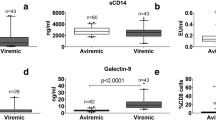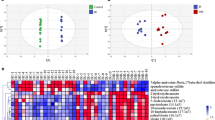Abstract
Golgi protein-73 (GP73) is upregulated in cancers and viral infections; however, its role in human immunodeficiency virus (HIV) and acquired immune deficiency syndrome (AIDS) remains undetermined. GP73 was evaluated as a biomarker of HIV progression and AIDS treatment efficacy. Forty-eight HIV patients (≤350 CD4 + T cells/μL) undergoing highly active antiretroviral therapy (HAART group) and 18 HIV patients expected to undergo HAART within 9 months (>350 CD4 + T cells/μL) (control group) were enrolled in a prospective, single center, cohort study from May 2009 to Jun 2012. Blood aspartate aminotransferase, alanine aminotransferase (ALT), cholesterol, triglycerides, and total bilirubin were assessed at baseline, 2 weeks, and 1, 3, 6, 9, and 12 months (HAART group) or 3 month intervals (control group). Serum HIV RNA level (viral load) was determined by reverse-transcriptase polymerase chain reaction (RT-PCR), and serum and peripheral blood mononuclear cell (PBMC) GP73 concentration were determined by chemiluminescent immunoassay kit and western blot, respectively. Significant positive and negative correlations in baseline serum GP73 concentration and HIV viral load (r = 0.39, P < 0.001) and CD4 + T cell count (r = −0.501, P < 0.001) were observed, respectively. In receiver operator characteristic (ROC) analysis, area under the curve (AUC) was 0.79 (95 % CI 0.66–0.92). The sensitivity and specificity of GP73 for correct identification of patients with ≤350 CD4 + T cells/μL were 76.09 and 75.0 %, respectively, with an ROC-derived cut-off of 100.6 ng/mL. For HIV patients undergoing antiretroviral therapy, GP73 may be a potential biomarker treatment efficacy useful in AIDS management.






Similar content being viewed by others
Abbreviations
- GP73:
-
Golgi protein-73
- HIV-1:
-
Human immunodeficiency virus type 1
- AIDS:
-
Acquired immunodeficiency syndrome
- PBMCs:
-
Peripheral blood mononuclear cells
- HAART:
-
Highly active antiviral therapy
- HBV:
-
Hepatitis B virus
- HCV:
-
Hepatitis C virus
- ALT:
-
Alanine transaminase
- AST:
-
Aspartate aminotransferase
- Tbil:
-
Total bilirubin
- LDL-C:
-
Low density lipoprotein-cholesterol
- ALB:
-
Albumin
- PVL:
-
Serum viral load
- RT:
-
Reverse transcriptase
- PR:
-
Protease
References
Quinn TC, Overbaugh J (2005) HIV/AIDS in women: an expanding epidemic. Science 308:1582–1583
Yousaf MZ, Zia S, Babar ME, Ashfaq UA (2011) The epidemic of HIV/AIDS in developing countries; the current scenario in Pakistan. Virol J 8:401
Drannik AG, Henrick BM, Rosenthal KL (2011) War and peace between WAP and HIV: role of SLPI, trappin-2, elafin and ps20 in susceptibility to HIV infection. Biochem Soc Trans 39:1427–1432
Deeks SG (2011) HIV: how to escape treatment. Nature 477:36–37
Puren A, Gerlach JL, Weigl BH, Kelso DM, Domingo GJ (2010) Laboratory operations, specimen processing, and handling for viral load testing and surveillance. J Infect Dis 201(Suppl 1):S27–S36
Mermin J, Ekwaru JP, Were W, Degerman R, Bunnell R, Kaharuza F et al (2011) Utility of routine viral load, CD4 cell count, and clinical monitoring among adults with HIV receiving antiretroviral therapy in Uganda: randomised trial. BMJ 343:d6792
Nie T, Detorio M, Schinazi RF (2011) Universal profiling of HIV-1 pol for genotypic study and resistance analysis across subtypes. Antivir Ther 16:1267–1275
Menzies NA, Berruti AA, Berzon R, Filler S, Ferris R, Ellerbrock TV et al (2011) The cost of providing comprehensive HIV treatment in PEPFAR-supported programs. AIDS 25:1753–1760
Lichtfuss GF, Hoy J, Rajasuriar R, Kramski M, Crowe SM, Lewin SR (2011) Biomarkers of immune dysfunction following combination antiretroviral therapy for HIV infection. Biomark Med 5:171–186
Lewin SR, Rouzioux C (2011) HIV cure and eradication: how will we get from the laboratory to effective clinical trials? AIDS 25:885–897
Kladney RD, Bulla GA, Guo L, Mason AL, Tollefson AE, Simon DJ et al (2000) GP73, a novel Golgi-localized protein upregulated by viral infection. Gene 249:53–65
Mao Y, Yang H, Xu H, Lu X, Sang X, Du S et al (2010) Golgi protein 73 (GOLPH2) is a valuable serum marker for hepatocellular carcinoma. Gut 59:1687–1693
Schwegler EE, Cazares L, Steel LF, Adam BL, Johnson DA, Semmes OJ et al (2005) SELDI-TOF MS profiling of serum for detection of the progression of chronic hepatitis C to hepatocellular carcinoma. Hepatology 41:634–642
Marrero JA, Romano PR, Nikolaeva O, Steel L, Mehta A, Fimmel CJ et al (2005) GP73, a resident Golgi glycoprotein, is a novel serum marker for hepatocellular carcinoma. J Hepatol 43:1007–1012
Riener MO, Stenner F, Liewen H, Soll C, Breitenstein S, Pestalozzi BC et al (2009) Golgi phosphoprotein 2 (GOLPH2) expression in liver tumors and its value as a serum marker in hepatocellular carcinomas. Hepatology 49:1602–1609
Laxman B, Morris DS, Yu J, Siddiqui J, Cao J, Mehra R et al (2008) A first-generation multiplex biomarker analysis of urine for the early detection of prostate cancer. Cancer Res 68:645–649
Wei S, Dunn TA, Isaacs WB, De Marzo AM, Luo J (2008) GOLPH2 and MYO6: putative prostate cancer markers localized to the Golgi apparatus. Prostate 68:1387–1395
Zhang F, Gu Y, Li X, Wang W, He J, Peng T (2010) Up-regulated Golgi phosphoprotein 2 (GOLPH2) expression in lung adenocarcinoma tissue. Clin Biochem 43:983–991
Li XY, Liu W, Chen SF, Zhang LQ, Li XG, Wang LX (2011) Expression of the Golgi phosphoprotein-3 gene in human gliomas: a pilot study. J Neurooncol 105:159–163
Fritzsche FR, Kristiansen G, Riener MO, Dietel M, Oelrich B (2010) GOLPH2 expression may serve as diagnostic marker in seminomas. BMC Urol 10:4
Fritzsche FR, Riener MO, Dietel M, Moch H, Jung K, Kristiansen G (2008) GOLPH2 expression in renal cell cancer. BMC Urol 8:15
Shi Y, Chen J, Li L, Sun Z, Zen L, Xu S et al (2011) A study of diagnostic value of golgi protein GP73 and its genetic assay in primary hepatic carcinoma. Technol Cancer Res Treat 10:287–294
Tamura K, Dudley J, Nei M, Kumar S (2007) MEGA4: molecular evolutionary genetics analysis (MEGA) software version 4.0. Mol Biol Evol 24:1596–1599
Shipley TW, Kling HM, Morris A, Patil S, Kristoff J, Guyach SE et al (2010) Persistent pneumocystis colonization leads to the development of chronic obstructive pulmonary disease in a nonhuman primate model of AIDS. J Infect Dis 202:302–312
Vining DJ, Gladish GW (1992) Receiver operating characteristic curves: a basic understanding. Radiographics 12:1147–1154
De Milito A (2004) B lymphocyte dysfunctions in HIV infection. Curr HIV Res 2:11–21
Morota K, Nakagawa M, Sekiya R, Hemken PM, Sokoll LJ, Elliott D, Chan DW, Dowell BL (2011) A comparative evaluation of Golgi protein-73, fucosylated hemopexin, α-fetoprotein, and PIVKA-II in the serum of patients with chronic hepatitis, cirrhosis, and hepatocellular carcinoma. Clin Chem Lab Med 49:711–718
Athan E, O’Brien DP, Legood R (2010) Cost-effectiveness of routine and low-cost CD4 T-cell count compared with WHO clinical staging of HIV to guide initiation of antiretroviral therapy in resource-limited settings. AIDS 24:1887–1895
Bachert C, Fimmel C, Linstedt AD (2007) Endosomal trafficking and proprotein convertase cleavage of cis Golgi protein GP73 produces marker for hepatocellular carcinoma. Traffic 8:1415–1423
Liu X, Wan X, Li Z, Lin C, Zhan Y, Lu X (2011) Golgi protein 73(GP73), a useful serum marker in liver diseases. Clin Chem Lab Med 49:1311–1316
Hu JS, Wu DW, Liang S, Miao XY (2010) GP73, a resident Golgi glycoprotein, is sensibility and specificity for hepatocellular carcinoma of diagnosis in a hepatitis B-endemic Asian population. Med Oncol 27:339–345
Iftikhar R, Kladney RD, Havlioglu N, Schmitt-Graff A, Gusmirovic I, Solomon H et al (2004) Disease- and cell-specific expression of GP73 in human liver disease. Am J Gastroenterol 99:1087–1095
Martin-Carbonero L, de Ledinghen V, Moreno A, Maida I, Foucher J, Barreiro P et al (2009) Liver fibrosis in patients with chronic hepatitis C and persistently normal liver enzymes: influence of HIV infection. J Viral Hepat 16:790–795
Wright LM, Yong S, Picken MM, Rockey D, Fimmel CJ (2009) Decreased survival and hepato-renal pathology in mice with C-terminally truncated GP73 (GOLPH2). Int J Clin Exp Pathol 2:34–47
Acknowledgments
This work was supported by a grant from the National Natural Science Foundation of China (No.81071411; 81271901) and by the Beijing Municipal Science and Technology Commission (No. D09050703590903).
Conflict of interest
The authors declare no conflicts of interest.
Author information
Authors and Affiliations
Corresponding authors
Additional information
Hongshan Wei and Xiaohua Hao have contributed equally to this work.
Rights and permissions
About this article
Cite this article
Wei, H., Hao, X., Li, B. et al. GP73 is a potential marker for evaluating AIDS progression and antiretroviral therapy efficacy. Mol Biol Rep 40, 6397–6405 (2013). https://doi.org/10.1007/s11033-013-2754-5
Received:
Accepted:
Published:
Issue Date:
DOI: https://doi.org/10.1007/s11033-013-2754-5




